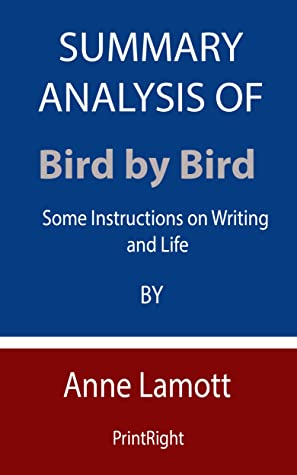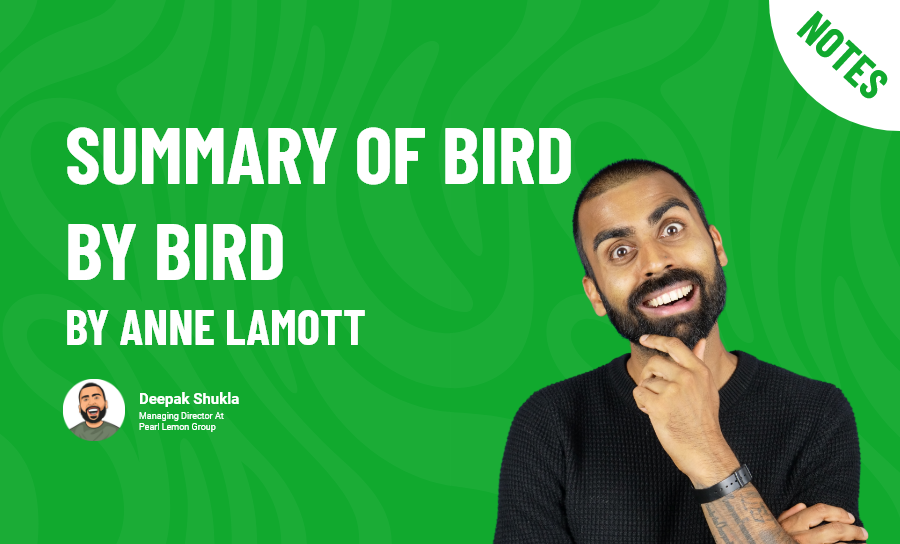Reading Time: 3 minutes

Click this link to purchase from Amazon
Click this link to purchase from Audible

Deepak Shukla’s Notes On Summary of Bird by Bird by Anne Lamott – Notes:
Hey guys,
I finished reading this book on the 10th January 2021.
Here’s a synopsis of the book I grabbed from Amazon:
“Told frоm thе реrѕоnаl реrѕресtіvе оf author Annе Lamott, Bіrd bу Bіrd іѕ a guide toward bесоmіng a better writer and іmрrоvіng уоur lіfе аlоng thе wау. Lamott’s dіѕtіnсtіvе аррrоасh, hоnеѕtу and personal аnесdоtеѕ make this bооk a must fоr wrіtеrѕ or аnуоnе whо wаntѕ tо become оnе.”
And here are my actual notes I took whilst I was listening to this on Audible:
- You can write stories as gifts to people you love
- Scribble ideas as you go about your day. Can even scribble dialogue ideas verbatim
- Your moral value does not have to come to pass even if the main character believes it to be so
- Best write about values you are passionate about In your books
- Especially things that catch you off guard
- Become highly observant to the world around you
- Plot Treatment: About filling in spaces that are unclear
- Immerse themselves in set design as an aspect of the work as it also tells you about characters
- Set Design
- Setting and feeling of a room is important
- From objects in a room, to lighting, to placement of objects – settings are an extension of a character
- How to write dialogue
[convertful id=”197358″]
- Read the dialogue out loud
- Ensure each character sounds different
- Speech mannerisms should identify each character
- Try and put characters together who would never want to be together
- Use dialogue to let characters say what they will say and what they will not say
- Let’s characters explode and also keep some back
- ABCDE split formula
- A for action
- B for background
- C climax – develop the story until things change in a significant way for the main characters
- D for development (give characters personas so they know what they care about)
- E ending – give reader sense of ending what it meant and what it reveals about the characters
- A climax should feature a domination, a healing or a killing
- One character must be profoundly changed by the climax
- A story that features no change is a failed story
- Towards the end the story has to have a major scene that brings everything together
- As long as the characters are moving the readers will stay with the story
- The plot is determined by the characters and how they engage with each other and the narrator
- Writers must be open to characters and give them the freedom to become what they want to become
- A character is as important as the narrator
- Narrators should be human. Flawed
- Nothing is as important as a likable narrator
- What are their beliefs dreams and ambitions
- What would this character do in X situation?
- If this character kept a journal what entries would he/she make
- What are the routines and beliefs of character X?
- Pull character facets from people you know in real life to build authenticity
- For each character, something must be at stake
- Good characters also do bad things
- Protecting good characters from bad things will make a story flat
- A determined writer can write just about anything and can make a good show of it
- Only by writing about anything can you become a good writer
- Any memory can be a good story if it is well written
- Good writing emerges when the writer focussed on telling the truth
- Write stories of the world around you and exaggerate what you see to build compelling short stories
- Budding writers must make a commitment to write more
- Can write great stories by beginning with small details, observing their surroundings, exploring their memories and following their intuition



